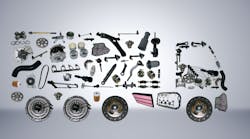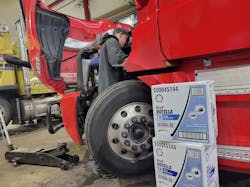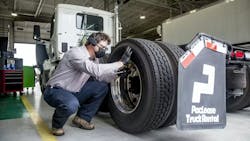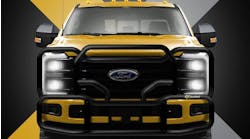Fleet managers know the importance of ROI per asset, and maintenance departments can indirectly increase profits when considering ROI with vehicle parts. By doing just a bit more homework on the maintenance side, service professionals can determine whether aftermarket or OEM parts best suit the fleet's needs with durability, availability, and performance. Further, potentially decreasing unscheduled repairs when employing the best-suited vehicle parts can make that additional homework well worth it.
Below, experts share their reccommendations and tips on purchasing filters, engine oils, and tires in ways that maximize their value.
Choose filters with the best value
Fleets will often shop around for filters, and finding the best value requires a product that aligns with the fleet's maintenance objectives while also meeting a minimum performance standard.
For example, a fleet looking to extend its vehicles' oil-drain interval might find success paying more for high-end filters.
“Maybe you’re averaging three oil changes over the course of a year,” said Willie Reeves, former director of maintenance at PacLease, Paccar’s leasing company that provides full-service lease, rental, and maintenance programs for Kenworth and Peterbilt trucks. “But maybe the oil viscosity is still at 40-50% and might be able to make it to the next PM. Using high-quality, extended-life filters could help extend that PM and drive uptime.”
However, extended-life filters may not be the best value for each fleet or vehicle. Ernest Acevedo, director of fleet maintenance and onboard technologies at Massachusetts-based Boyle Transportation, used the example of a reefer that has a premium filter advertised to last up to 3,000 hours. If the fleet decided to be proactive and replace the filter every 1,500 hours, paying more for that premium filter wouldn’t make sense. In this instance, buying a less expensive filter rated up to 2,000 hours would offer more value, Acevedo said.
“Whatever you decide with any type of filter, just make sure you have a quality product that will perform to OEM standards,” added Paul Pettit, VP of maintenance for Riverside Transport, who has held various fleet maintenance leadership positions since 2005. “You also want to balance quality with cost. The most expensive filter out there is not always necessary. But you don’t want to go with the cheapest, either, if you’re trying to protect your engine warranty coverage and meet the minimum standards. A catastrophic failure and voided warranty could end up costing a lot more than a high-end filter.”
With engine oil, do your homework
Another area where fleets have a lot of options is with engine oil. Before deciding, it’s imperative to assess the performance needs of the vehicle. API certification can help; however, not all API-certified oils are created equal.
“Other benefits like corrosion protection and liner wear protection could be included in certain oils, delivering another level of performance that gives fleets something else to evaluate,” said Greg Matheson, product manager for commercial engine lubricants at Lubrizol, a specialty chemicals company whose additives are used by a variety of OEMs and aftermarket marketers.
Fleets must also confirm that the oil in consideration is OEM-approved, Matheson said. Some oils may only be approved for use in older vehicles, while other products may promote “suitable for use in” a certain engine. This doesn’t indicate poor performance in other engines; it just means a service professional will need to do a bit more homework.
“It’s important to have conversations with both the OEM and your oil suppliers,” Matheson said. “Ask for data showing how the oil performs from a wear protection perspective. Also ask for data on oxidation control because that can help extend an oil drain or at least maximize performance within the oil drain.
See also: How to spec the right engine oil for better efficiency and performance
“Understanding these things will help fleets fully understand the performance benefits from one oil to another,” he continued.
Using a high-performance oil could also help fleets realize long-term cost savings. Oils with extended drain intervals can help reduce downtime, saving money. Further, better component protection, such as with camshafts, pistons, and liners, can help improve engine efficiency.
“Oils meeting API CK-4 certification are formulated and rigorously tested to withstand high temperatures, heavy loads, and extended service intervals,” said Jeff Harmening, senior project manager at the American Petroleum Institute. “CK-4 oils also provide shear stability, oxidation resistance, and aeration control, and they are engineered to meet stringent emissions requirements. API-certified CK-4 engine oils are vital for heavy-duty engine performance, reducing maintenance costs, and complying with industry standards.”
Going further, API FA-4 oils can provide an even stronger ROI advantage despite a higher upfront cost, Matheson said.
“The fleets I’ve talked to said FA-4 oil costs a little more per gallon, but say they are reducing fuel costs,” Matheson said. “They’ve done the ROI analysis, and the savings outweigh the extra cost of the oil. That’s what is most important to a fleet maintenance manager.”
It might also benefit fleets to employ synthetic oils. Although synthetic oil typically comes at a higher price, the long-term savings could outweigh those costs.
“A full synthetic or a synthetic blend provides advanced engine protection and enhanced performance,” said Karin Haumann, OEM technical manager for Shell Global Solutions. “These cutting-edge lubricants guard against the damaging consequences of metal-to-metal contact, high loads, cold starts, and prolonged idling. In addition to safeguarding your engine, synthetic oils can enhance fuel economy and operational efficiency in addition to helping reduce CO2 emissions.”
Another important area for fleets to consider is viscosity, asserted Steven Bowles, senior lubes product specialist at CITGO.
“New low viscosity heavy-duty engine oils (HDEOs) serve double duty,” he explained. “They go low enough to flow at low temperatures and high enough to protect and perform at high temperatures.”
The gains resulting from engine performance also yield significant fuel savings, he added.
“A switch from 15W-40 to 10W-30 can result in up to 3% fuel savings through outstanding oxidation performance,” Bowles noted.
One real-world example to consider is with Brundage-Bone, a construction fleet. The fleet changed to CITGARD 700 Synthetic Blend SAE 10W-30 on its concrete pumping trucks, and telematics data revealed a 2.5% annual fuel savings, according to CITGO. Bowles advised, however, that changing to a lower viscosity oil with the sole purpose of achieving better fuel economy should not come at the cost of engine durability or emissions system compatibility.
Overall, fuel efficiency is a benefit that’s relatively simple to measure, while other benefits of using a premium oil aren’t so easy to put a number on. That’s why Matheson encourages oil analysis.
“At a minimum, it’s a good idea to draw an oil sample when doing an oil change,” he said. “Send that sample to a reputable third party for analysis. The results will tell you about wear metals and other things going on with the oil. This helps fleets understand how the oil is performing.”
Strategize tire purchases
Tires represent another area where a fleet might consider price shopping. The ramifications of tire performance on driver satisfaction, safety, and fuel economy can have a major impact on life cycle ROI.
“Plus, given the cost of rubber and availability of tires these days, tires are something a fleet definitely doesn’t want to take too many chances on,” PacLease’s Reeves said.
The tire with the most value will likely be identified by the fleet’s overall mindset.
“There are price fleets, and there are cost fleets,” said Kevin Rohlwing, chief technical officer at the Tire Industry Association. “Cost fleets want to know how much a tire is going to cost per mile, or maybe per 32nd in a severe-duty application. Price fleets want to know how much money is being taken out of their pocket right then. They don’t really care about brand name, where the product is from, or the warranty.”
Linehaul fleets should adopt a cost-per-mile mindset, according to Rohlwing.
That mindset requires pilot testing and a commitment from the maintenance team. Every tire in the fleet, not just those being tested, should be regularly measured for an honest comparison.
See also: Tire makers discuss spec'ing commercial tires by duty cycle
“Check tread depth and tire pressure, and note the odometer readings,” Rohlwing advised. “When you can get to where the level of maintenance on a regular tire is just as good as a test tire, you’ll be able to determine the lowest cost-per-mile tire every time.”
Cost per mile for a linehaul fleet includes a couple of retreads and all maintenance costs in between. Vocational applications and city delivery applications that aren’t interested in retreads due to a higher risk of damage can attain value by balancing that initial tread life with tire cost.
“Where it gets interesting with these types of fleets is with steer tires,” Rohlwing said. “Even some price-driven fleets will spend money on name-brand steers.”
What’s the thinking here?
“If one of the four tires on the rear axle blows out, they feel like they’ll be OK,” the tire expert said. “But if they lose a steer tire, that’s a whole different animal for both the driver and the cargo. So this is another tire strategy some fleets choose to follow to balance performance and cost.”
Standardize the 'perfect' parts
The balance between cost and downtime is a sound replacement parts strategy, but product availability also deserves consideration. Building strong partnerships with vendors can help decrease the amount of time a vehicle sits in a shop waiting for a part.
Partnering with a few key vendors can also help fleets leverage buying power for more favorable parts pricing. This is why Pitt Ohio, an LTL trucking fleet covering the Northeast, Midwest, and Mid-Atlantic, standardizes the same brake system across all its fleet vehicles.
“Then we only need to stock one type of OE brake pad, brake shoe, and so on,” said Kurt Dunn, senior fleet technical adviser at Pitt Ohio. “By leveraging our relationship with the manufacturer, we can really stock up and get the best pricing. Some people say it’s not smart to put all of your eggs in one basket. But for us, with most of the supply issues during COVID behind us, standardizing and streamlining is working very well.”
Pitt Ohio—and any other fleet—just needs to make sure it standardizes with the perfect part that balances performance, cost, and downtime.





